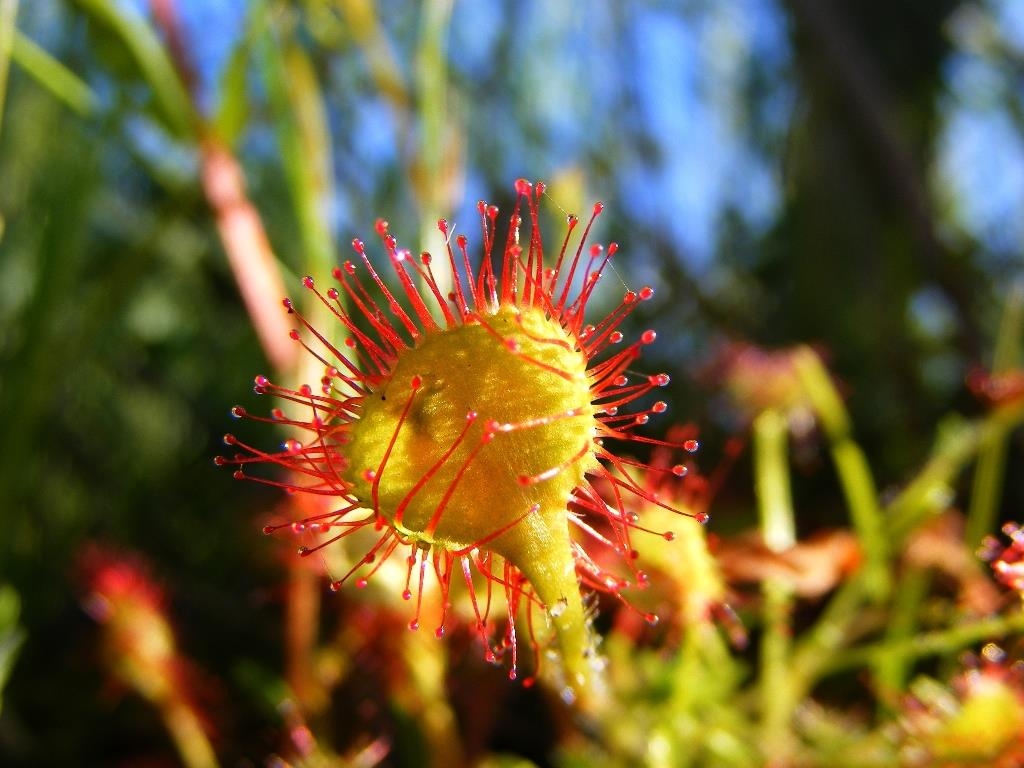Flora

The flora of Poleski National Park is one of its main attractions. The most characteristic and precious element are the waste turf lands, distinguishing this area from all other national parks in Poland.
Two hundred and eight plant complexes have been indentified, from which 30 present forest and thicket complexes, and the remaining 178 are non-forest formations. The PNP flora is represented by around 260 algae species, 130 bryophyte species (the most numerous are peat mosses- 13 species- angled paludella moss, scorpidium moss- both species are endangered) and around 1,000 vascular plant species (of these, 107 are rare species). One hundred and twenty species are the representatives of Central European flora. Almost 140 species are plants of the northern area: betula humilis (the biggest population in the country), and the downy willow and swampy willow should also be mentioned. Those three species are typical post-glacial relicts and they are in great numbers in the Park; among others are creeping sedge and shore sedge, pedicularis sceptrum-carolinum, rannoch rush, English sundew, Siberian iris, silene lituanica. Atlantic relicts (around 25 species) are among others: smooth cat's ear and teesodalia nudicaulis. There are also grassland (pontic) and mountain plants in the Park. To this last group belong such plants as white hellebore, Tofield's asphodel, and the fragrant orchid.
The border of incidence for around 150 plant species runs through the park area. There are 81 species of protected vascular plants, 36 of them are on Polish Red List of Threatened species. Species encountered as endangered in the Park are carnivorous waterwheel plant, red helleborine, ostericum palustre Besser, and the common butterwort. The remaining 32 species are encountered as an endangered or rare category. Ladybells deserve special attention, having the only place in Lubelszczyzna region, and a few species of sedges: Davall's sedge, creeping sedge, Buxbaum's sedge, rope-root sedge, shore sedge and related with them rusty bogrush. Many of them create the whole complexes of plants in vast areas, while in other regions of the country they occur in single positions. The most interesting group of plants, which are orchids, is represented in the Park by 14 species and 1 sub-species. The rarest (1 position only) are the lady's-slipper orchid and the sword-leaved helleborine, the position of the latter has not been found, and the red helleborine and liparis loeselii, having two positions here. Among this group of rare plants belong the lesser butterfly-orchid, the greater butterfly-orchid, the broad-leaved marsh orchid, the moorland spotted-orchid, the fragrant orchid, the broad-leaved helleborine, and the greenless and parasitical European common twayblade. However, the early marsh orchid and the marsh helleborine are the most common orchids of the Park, and only the sub-species of the yellowish early marsh orchid occurs rarely in the Bubnow and Staw Swamps [Bagno Bubnów and Bagno Staw].
Exceptionally interesting is also the fact of the existence of eight species of carnivorous plants in the Park turflands. Those are the waterwheel plant, the English sundew, the oblong-leaved sundew, the round-leaved sundew, the obovateleaf sundew (cross-breed), the common butterwort, the common bladderwort, the flat-leaf bladderwort, and the lesser bladderwort. These plants, in different ways, have adjusted to supplement nitrogen deficiency, which they cannot gain from the soil on turflands. Waterwheel plant and bladderworts evolved to catch small invertebrates in the prehensile traps of the detent type with a special slowing down mechanism. In bladderworts it was modified into the vacuum variety. The victim is sucked with water inside of the empty bubble the moment the detent is opened. A single common bladderwort can create on a single leaf 400 traps like that. Sundews and butterwort have glutinous traps. The leaves of sundew have glandular hair, at the ends of which are drops of "something similar to dew" (this is where the name of the plant comes from. This dew is very viscous and fragrant, and its task is to lure insects. When an insect sits on a leaf, it becomes glued to it, and the plant rolls the leaf producing digestive substances and absorbs the "melted" protein of the victim, leav-ing just a chitin crust.
Among mushrooms protected in the area of the Park, just five species have been observed. These, which appear in early spring, and even in March, are the black morel (conical), sponging on trees hen-of-the-woods, or existing in mycorrhiza with pines- cauliflower mushroom, and also parasitic bolete and a giant puffball, the fruiting body of which reaches the size of a football, or even a basketball. The afore-mentioned species are rarely seen in the Park, even sporadically. A protected mushroom with a very characteristic shape and an intense, sweet-blend smell, the common stinkhorn, can be seen in great numbers.